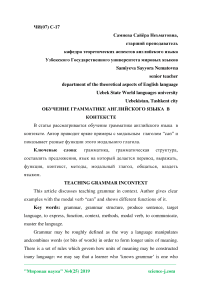Teaching grammar in context
Автор: Samiyeva S.N.
Журнал: Мировая наука @science-j
Рубрика: Основной раздел
Статья в выпуске: 4 (25), 2019 года.
Бесплатный доступ
This article discusses teaching grammar in context. Author gives clear examples with the modal verb “can” and shows different functions of it.
Grammar, grammar structure, produce sentence, target language, to express, function, context, methods, modal verb, to communicate, master the language
Короткий адрес: https://sciup.org/140264363
IDR: 140264363
Текст научной статьи Teaching grammar in context
Grammar may be roughly defined as the way a language manipulates andcombines words (or bits of words) in order to form longer units of meaning. There is a set of rules which govern how units of meaning may be constructed inany language: we may say that a learner who ‘knows grammar’ is one who hasmastered and can apply these rules to express him or herself in what would be acceptable language forms [1].
Grammar is rules of a language. “Grammar is a system of meaningful structures and patterns that are governed by particular pragmaticconstraints” [2]. In another definition “grammar is a description of the rules of forming sentences, including an account of the meanings that this forms convey” [3].
“Grammar is something that produces the sentences of a language. By something we mean a speaker of English. If you speak English natively, you have built into you rules of English grammar. In a sense, you are an English grammar. You possess, as an essential part of your being, a very complicated apparatus which enables you to produce infinitely many sentences, all English ones, including many that you have never specifically learned. Furthermore by applying you rule you can easily tell whether a sentence that you hear a grammatical English sentence or not.” [4].In order to understand a language and to express oneself in clear way everyone must assimilate the grammar structure of the language studied. Indeed, one may know all the words in a sentence and yet fail to understand it, if one does not see the relation between the words in the given sentence. And on the contrary, a sentence may contain one, two, and more unknown words but if one has a good knowledge of the structure of the language one can easily guess the meaning of these words or at least find them in a dictionary.No speaking is possible without the knowledge of grammar, without the forming of a grammar structure.If a learner has acquired such a structure, he can produce correct sentences in a foreign language . A command of English as is envisaged by the school syllabus cannot be ensured without the study of grammar. Pupils need grammar to be able to listen, speak, read, and write in the target language.
A lot of scientists in Uzbekistan such as: J.B. Buranov, J.J. Rasulova M.I., Jalololov, T.K. Sattarov, G.T. Makhkamova, K.N. Karayeva, L.T. Akhmedova, V.I. Normuratova, I.Yakubov, showed teaching methods of English grammar.
In this article we are going to see other examples of functions and how they are connected to specific grammatical structures.If we give such kind of question “ Can you drive?” , we will be giving a question using modal verb Can , which follows a specific pattern:CAN (modal verb) + pronoun (you) + main verb in base form (drive)?This combination of words is essential to the meaning, the intention you are trying to communicate to the listener. But, what are you communicating? What is the function of this question?The function is ‘asking about ability’, the ability to drive; if the person knows how to drive. This could be a question asked in the context of a job interview.
Contextualization is one of the main features of Communicative Language Teaching. A sentence said in different contexts can change the function wholly. In some situations, the grammatical pattern remains the same. For example: “Can you drive? I’ve drunk a couple of beers”. The speaker is not asking about the ability the listener has to drive a vehicle, or if he has a driving license. He is requesting, asking for a favor.
Next example which we are going to analyse: Two women are talking about rules in a foreign country and one asks to the other woman, who is from Saudi Arabia: Can you drive? The context clearly shows that the question refers to ‘permission’; if the person is allowed to drive.
Sometimes a change of pronoun or adding a word can change the function. Imagine that a group of friends are planning a trip to the forest. They have a map and they have to decide how to get to their destination. One looks at the map and asks: Can we drive there? The grammatical pattern is still the same: Modal Can + pronoun+ verb in base form? But the speaker is surely asking about how possible it is for them to reach their destination by car.
When choosing a grammar topic to teach, make sure that you can identify the pattern or structure, and the function so that you can create a good context, or situation to present the grammar topic communicatively.
Making a conclusion, grammar instruction is a difficult issue in language teaching. Teaching grammar through context will help learners perceive the structures of the language effectively. If learners are given grammatical structures in the context, they will be able master the language better. Teaching grammar in context will help learners to acquire new grammar structures and forms. Learners will use grammatical conventions more effectively in communication if they learn them in context.
Список литературы Teaching grammar in context
- Ur Penny. Grammar Practice Activities: A Practical Guide For Teachers. -Cambridge, Cambridge University Press.1998. - p. 4.
- Larsen -Freeman Diane, Techniques and principles in language teaching, 2 -nd edition, 2001
- Thornbuy Scott, How to teach grammar, 1999, p 13
- Paul Roberts, Understanding grammar, 2001


